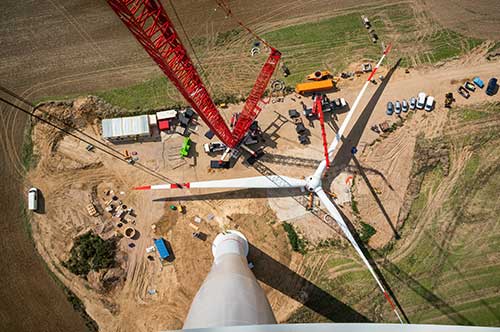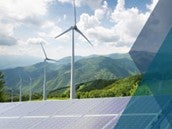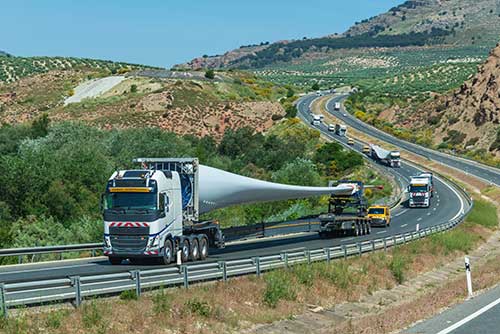— Published on 12 Sep 2024
Though solar projects are dominating discussions in renewable energy circles, wind energy still plays a major role in our clean energy future. We shouldn’t forget that wind farms currently produce 380GWh of electricity in the U.S. and 2100TWh worldwide, 80% more than solar. Likewise, once we get a handle on the technological hurdles of offshore production, we can expect a wind renaissance. The future of wind energy is big – seriously, the turbines are getting larger – here’s why.
To understand why it makes sense to build larger wind turbines, let’s start with how we get power from the wind. Wind is air moving like a fluid, put in motion by the spinning of the earth and heating and cooling of the ground by the sun. It contains a lot of kinetic (motion) energy. The blades of a wind turbine are pushed by air flowing over the airfoil surfaces, transferring some of the energy from the wind into rotating the blades, which drives a generator to produce electricity.
At a fundamental level, the amount of electricity you can produce is limited by the speed of the wind. Doubling wind speed more than doubles the amount of energy available to harness. The kinetic energy formula squares the variable for velocity, thus, doubling speed increases energy of the wind by 4x. This makes sites with exceptionally strong winds very attractive for development.
Turbine blade length also has an outsized effect on power production because it changes the area of the circle swept by the blades. The swept area is basically the amount of total wind the turbine can harness. Doubling the length of the blades increases the total swept area by 4x, because the radius of a circle is squared before it’s multiplied by Pi to find area. This is the first reason turbines keep getting bigger; the swept area increases quickly as blades get longer.

The quality of a potential wind farm site is driven by several factors, but the availability of consistent, strong winds is the most important. Due to some physics that we don’t need to get into, turbine power output increases as a cubic function of the wind speed. So, if you double wind speed, you can generate 8x the power through the turbine. As a result, substantially more total energy is produced at above average wind speeds than below.
You probably noticed how wind speed is generally higher and more consistent the farther you are from the ground. Think of climbing an observation tower and how a slight breeze can increase gradually into a steady wind as you ascend higher. This is because objects near the ground, such as buildings and trees, cause turbulence and slow the wind. Above these objects you experience uninterrupted flow and higher speeds, an effect called wind shear. Therefore, the second reason to build a larger turbine is to expose the blades to stronger, more consistent winds to produce more power.

When you combine the multiplying advantages of larger swept areas and higher wind speeds it helps to justify the engineering challenges of building the massive turbines of the future. But why not just add more blades?
Intuitively, adding blades would produce more energy, but it turns out that three blades are best for utility scale turbines. There are a few reasons, but the main one is a limit to the amount of energy that can be extracted from the wind by a turbine.
In theory, it is about 60% of the total kinetic energy, while in practice it’s closer to 45%. This is because capturing 100% of the energy would reduce the airspeed behind the turbine to zero, stopping the flow of air over the blades. A significant amount of wind needs to flow through to keep the blades turning fast enough.
Efficiency gains drop off significantly once you move from two blades to three, and adding blades adds cost while introducing some other negative effects. With three blades, the peak loads experienced by the blade exposed to the fastest winds at the top of the circle are offset by the two blades experiencing slower speeds at the bottom. Four and five blade designs remove this natural balancing effect without generating significant power gains.

To produce more power, building bigger is the best way. It’s not without challenges, however. The latest modern 10MW+ mega-turbines have towers that are well over 100m tall, with heavy power cables needing to run the entire vertical stretch. Super long blades are also hard to produce, let alone transport, so assembling the final structure is an engineering feat on its own. Plus, you need a lot of land. Or maybe not?
As you plan your next project we're here to help. Connect with a Renewable Energy Expert or explore our wind energy resources to learn more about our product solutions.
Large Paragraph Text Used As A Subheading
Pellentesque non magna eget ex lobortis finibus. Lorem ipsum dolor sit amet, consectetur adipiscing elit. Etiam nec arcu non eros hendrerit viverra a vitae libero. Etiam et ultricies nulla. Donec euismod lectus magna, eu dignissim mauris hendrerit vulputate.
| Time | Place | Details |
|---|---|---|
| 10:00 am - 10:55 am | Expo Hall | Meet and greet in the lobby outside the Expo Hall before the General Assembly. |
| 11:00 am - 11:55 am | Rm 314 | Expert Track: TOP 10 WAYS TO MAKE A DIFFERENCE IN THE INDUSTRY | John Dough, CFO Marketizingly |
| 11:00 am - 11:55 am | Rm 159 | Social Track: MODERN NETWORKING | Hosted by: SponsorName |
Pellentesque non magna eget ex lobortis finibus. Lorem ipsum dolor sit amet, consectetur adipiscing elit. Etiam nec arcu non eros hendrerit viverra a vitae libero. Etiam et ultricies nulla. Donec euismod lectus magna, eu dignissim mauris hendrerit vulputate.